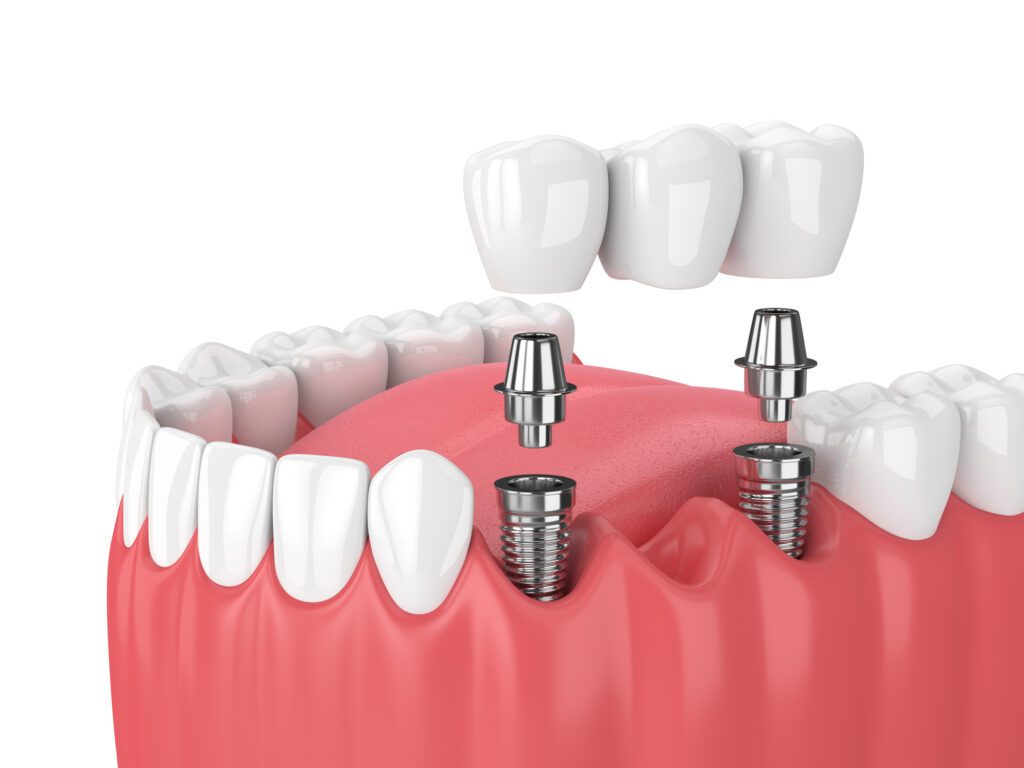Your dentists at Bella Smiles in Riverhead, Nesconset, and Roslyn, NY, offer the best dental bridge treatment options. Your dentist can use a dental bridge to replace one or several consecutive missing teeth. Dental bridges are a restorative dentistry treatment Bella Smiles provides to our patients in Long Island, NY. Our implant dentist can also permanently secure your dental bridge using dental implants for a comfortable and confident smile.
We secure traditional dental bridges by using existing teeth on either side of the gap as anchors. When dentists use existing teeth, they place a dental crown to add strength and ensure a lasting restoration. Our team can also surgically place dental implants as a permanent tooth replacement solution. Continue reading to learn more about these options.
Implant-Supported Bridges

A popular service, implant-supported bridges are the best option for replacing a row of teeth. Our dentists routinely use implant bridges to replace multiple lost teeth in a row. This is an ideal option for patients who want a permanent result but don’t want to damage adjacent natural teeth.
Dentists secure traditional bridgework by placing dental crowns over the adjacent teeth. The dentist will need to file down those teeth to accommodate the crowns. However, by using dental implants, the surrounding healthy teeth will stay intact.
Instead of placing a traditional fixed bridge for a single missing tooth, we recommend an implant-supported crown. This will avoid damaging the healthy adjacent teeth. Implants promote continued bone growth in your jaw, thus preventing bone loss and gum recession. An implant will actually replace the lost tooth root which will provide stimulation for the bone to prevent it from shrinking.
Dental Bridges at Bella Smiles
The dental bridge procedure will begin with a consultation to assess your dental health and plan your treatment. Depending on the health of your existing teeth, you will have the option to use dental crowns or dental implants to secure the bridge. The treatment goal is a long-lasting dental bridge that provides natural function for your long-term oral health.
For a traditional bridge, we will prepare the abutment teeth for crown placement. Then we will take dental impressions. We will use those impressions to fabricate your restoration. Once it is ready, you will return to our office where our dentist will cement the bridge into place.
Our dental care team will explain all aspects of your dental bridge procedure before we begin. We will ensure that when you visit with us you feel comfortable during your treatment. For an implant-supported bridge, we will perform all phases of the treatment in one of our Long Island dental offices.
This makes treatment more convenient and consistent for a predictable result. The first step in the implant process is to surgically place the implants into your jaw bone. After 3 to 6 months, your Bella Smiles dentist will be able to connect the bridge to the implants.
Dental Bridge FAQs
What can’t you eat with a dental bridge?
You should avoid chewing very sticky and very hard foods with a traditional dental bridge. These types of foods can damage or get stuck on your bridge fairly easily. This can make it more difficult to clean under the bridge as well. You do not have to worry about this with an implant-supported bridge.
What happens if you get a cavity under a bridge?
If you get a cavity under a bridge, your dentist will need to remove it and fix the cavity. However, this is a rare occurrence. Dentists rarely need to remove a permanently-secured dental bridge. Be sure to floss under your bridge daily to protect it from hidden cavities.
What causes pain under a dental bridge?
Food stuck under a bridge for a while is the most common reason for pain in that area. Stuck-on food lets bacteria irritate your gums. Not flossing properly and daily under a dental bridge leads to gum disease. The cause of gum irritation and pain can also be from a bridge that doesn’t fit as well anymore.
How long after a tooth extraction can you get a bridge?
Most patients wait about 6 months after an extraction to get a bridge. This gives your mouth, and gum tissue time to fully heal before placing a permanent bridge. However, the exact timing can vary depending on each case, so consult with our dentist for personalized advice.
Do dental bridges look like real teeth?
Fixed bridges typically look very realistic. They cover gaps or groups of teeth to make them appear like perfectly aligned teeth in a row. We will design them to match the color of your surrounding teeth to ensure a natural look.
Schedule a Dental Exam and Bridge Consultation!
We offer dental bridges in our Roslyn, Nesconset, and Riverhead, NY offices for replacing missing teeth. Schedule an appointment today with Dr. Lotardo, Dr. Pop, or Dr. Caesar at Bella Smiles. We will discuss your oral health, concerns, and budget to see what treatment option is right for you.
